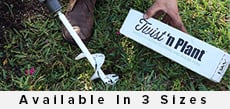A Flowerbed Garden
Our reader Thomas Hägg gives us a tour of his half-acre Swedish garden, located at the tip of a peninsula in the northern Stockholm archipelago, near Öregrund, an old fishing village.

Thomas Hägg, who runs his own PR agency in Stockholm, has been working on the garden in his country house for about four years. His house is located at the tip of a peninsula in the northern Stockholm archipelago, near Öregrund, an old fishing village. Hägg and his partner Tommy, who own the house together, spend every holiday, the whole summer, and weekends in the house with their two French bulldogs.
The garden, which spans about half an acre, is divided into thirds, with one third remaining as woodland, another third that is a meadow, and remaining third as a cultivated garden. These photographs, taken from April to September, show the work that Hägg has put into the garden over the past four years.

Did you have a philosophy or plan in mind when your started your garden?
We started digging quite spontaneously and the garden has grown ever since. We wanted an interesting garden with many different options and variations. We wanted it to blossom from spring to autumn, and we also wanted the opportunity to cultivate vegetables and herbs. Now, we have vegetables from early summer through October, with different kinds of carrots, garlic, beets, corn, spinach, lettuce, potatoes, herbs, artichokes, asparagus, and raspberries available.

Tell us a bit about the location of your garden.
We are in a unique location in the outer archipelago, which is in Zone 4-5. I've managed to get a number of unusual plants to overwinter despite the harsh winter climate, including a Magnolia stellata (star magnolia), which I cherish dearly. It probably survived because I laid out the big flowerbed in an old heap of stones. The stones hold the heat in the spring and the autumn, thus extending the growing season.

Would you say that there is a particular Swedish style in gardens, particularly in your neighborhood?
In my neighborhood, there is no specific tradition of gardening because it is an old agricultural landscape. But there are some beautiful plants in the plots: old peonies; this summer’s new favorite, Lilium martagon, columbines, and delicious-smelling wild honeysuckle and wild roses.

How long have you been working on this garden?
We've had the garden for about four years. When we moved into the house, there was nothing more than the forest and undergrowth. The first spring, we dug out a mound of stones, and started to plant the spring flowers in one corner of the flower bed and then continued to plant different kinds of plants as the season continued. The other big flower bed, next to the patio, is planted in the late summer, so that it blooms later in the season. But in the spring, it is filled with different kind of tulips, crocuses and alliums. And the last flower bed, which we made in the fall of 2010, is a mixture of different plants from existing flower beds, but is more symmetrical. There, the color palette is white, burgundy, and blue-purple.

Pictured: Pink Bleeding Heart
What plants have been successful in your garden? Which have been failures?
It's all trial and error. And so far, I have only had bad luck with sage and rosemary. Also honeysuckle and I don’t really enjoy each other's company, but I think it belongs in a garden, so I struggle on. From the beginning, I have invested time and effort into planting flowers that will bloom all year. In the early spring, we have Pulsatilla vulgaris, narcissi, and primroses; over the summer there are day lilies, Trollius chinensis, old giant poppies, my great-grandfather's peonies and daisies; throughout the fall, we have echinacea, anemones, and Actaea simplex; and even in the winter, we have grass that withstands the frost beautifully and hellebores.

How would you describe the style of your garden?
The flowerbeds are spontaneous and experimental, with a mixture of “modern” plants and old traditional Swedish plants, as well as manicured lawns bordering the cultivated meadows and woodland.

Any particular challenges with this space? How did you address them?
The garden had no real soil and the harsh winter climate and the dry summer are huge challenges, which thankfully, we did not understand when we started. The challenges are, and always will be, the winter cold and the drought in the summer. But to prevent the soil from drying, we've killed a birch tree, which stood at the edge of one bed, and let a few different varieties of clematis climb up and provide some shade for the other plants.

Is there a color theme to your garden?
There are varied color palettes throughout the garden. The flower garden in the mound of stones is an explosion of color, the flower bed next to our patio has a yellow and burgundy palette, and the new bed, next to the house, uses white, burgundy, blue, and purple flowers.

What are the challenges of growing a garden in Sweden, in terms of climate and plants?
The challenges vary tremendously, depending on where you live in Sweden, since the country contains of eight different climate zones. Down in the south, you can grow almost anything because they have mild winters and long, hot and humid summers. However, the risk of the plants getting damaged by the frost in the spring is rather large. In northern Sweden, the summers are very short, but on the other hand, the days are very long.

Can you tell us about some of the plants you used in your garden?
I probably have a hundred different varieties of plants in my garden, many of which are due to my trial-and-error attitude in my garden.
Most of the plants I have planted have survived and flourished. But I am particularly proud of and really enjoy my great-grandfather's peonies and giant poppies that we moved there.
We also have hellebores, mountain bamboo, anemones, Lilium martagon, columbines, various ornamental grasses, daffodils, climbing hortensia, different types of clematis, edelweiss, thyme, hosta plants, lilies, lilacs, orpines, and irises. Not to mention the 500 bulbs (tulips, daffodils, narcissi, crocuses, grape hyacinths, etc.) that I planted for the spring. The list goes on and on.

How do you think this garden reflects you and your family?
I think our garden shows that we really go in for our projects, and that despite our minimalistic style in home decoration (our home is actually called The Clinic) we are both creative and have a sense of color.

The masterpiece is finished! Now how are you going to change it next year?
Next year, we will expand the area for growing vegetables, and for the first time, enjoy the home-grown asparagus, which has tempted us for three years now. In the first big flower bed, we need to trim some herbs and flowers that have spread a bit too much. Then we have the little job of paving the driveway before we can sit down and enjoy watching everything grow.

Do you have any other advice you would like to share?
Go with your instinct and don’t be afraid to try something new. If you don’t like the plants or where they are planted, you can just move them around. Also, remember to keep the different heights of your garden in mind, and plant different plants that bloom throughout the season, from spring to autumn. But adapt the gardening to suit your own skill level.



